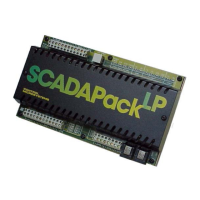5.2.1 Analog Input Connections
The six external analog inputs connect to connector P10. The analog inputs are identified as Channel
0 through Channel 5. The first five, identified as Channels 0 through 4, use range jumpers to select
either voltage inputs or current inputs. These analog inputs are single ended and measure voltages up
to 10V. When configured as current inputs, the 250Ω current sense resistor will produce at 5V input
at 20mA. See section 5.3-Analog Input Range Jumpers for information on setting the range. See
Figure 2: SCADAPack LP Board Layout section for the location of the range jumpers.
The sixth input, identified as Channel 5, is a 32.768V voltage input. This input is typically used to
monitor the input power or battery voltage.
5.2.2 Analog Input Wiring
The analog inputs support loop powered and self powered transmitters. Loop powered transmitters
are two terminal devices that connect between a power supply and the analog input. The loop current
continues from the power supply, through the transmitter and to ground through a 250Ω resistor built
into the 20mA input circuit. Self-powered transmitters have three terminals called power in, signal
out and common. Self-powered transmitters can have a current or voltage output. The signal out
connects to the Analog Input Channel, the common connects to GND and the power in connects to a
power supply.
There are three options for the user when selecting the power source. In all cases it is important for
the user to ensure that the transmitter has enough voltage for proper operation. The transmitter
manufacturer supplies the minimum operating voltage specification of the transmitter. The analog
input requires a minimum of 5V.
The first option is to use the SCADAPack LP VLOOP Supply that steps up the input voltage to 24V.
The stepped up voltage is available on the Analog Connector P10 and is labeled VLOOP. There is
sufficient power available here for the five analog inputs and two analog outputs all operating at
20mA. Significant power saving is possible by switching the Loop Supply off.
The second option is similar to the first except that the power supply is not stepped up to 24V. This
can be used with low voltage transmitters or when then the input voltage is sufficiently high that
further stepping up is not necessary. It is still possible to switch the supply off under program
control. When the step up is turned off, VLOOP is approximately 0.5V less that the power input
voltage.
The third option is to power the transmitter from a power supply supplied by the user.
5.2.3 Analog Input Wiring Examples
Figure 4: Analog Input Wiring shows example wiring of several transmitters.
• Channel 0 has a loop powered current transmitter connected to VLOOP.
• Channel 1 has a loop powered current transmitter connected to an external 24V power supply.
• Channel 2 is unused.
• Channel 3 has a self-powered voltage transmitter connected to an external 24V-power supply.
• Channel 4 has a self-powered current transmitter connected to an external 24V-power supply.
• Channel 5 is used to monitor the external 24V-power supply.
SCADAPack LP Hardware Manual
May 26, 2006
14

